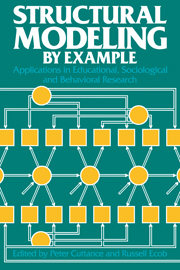Book contents
- Frontmatter
- Contents
- Preface
- List of contributors
- 1 Introduction
- 2 An overview of structural equation modeling
- 3 Field dependence and the differentiation of neurotic syndromes
- 4 High school seniors' reports of parental socioeconomic status: black–white differences
- 5 Modeling the hierarchical structure of learning
- 6 A study of longitudinal causal models comparing gain score analysis with structural equation approaches
- 7 Some structural equation models of sibling resemblance in educational attainment and occupational status
- 8 Applications of structural equation modeling to longitudinal educational data
- 9 The robustness of maximum likelihood estimation in structural equation models
- 10 An inquiry into the effects of outliers on estimates of a structural equation model of basic skills assessment
- 11 Testing structural equation models
- 12 LISREL models for inequality constraints in factor and regression analysis
- 13 Issues and problems in the application of structural equation models
- Appendix
- Glossary
- Index
6 - A study of longitudinal causal models comparing gain score analysis with structural equation approaches
Published online by Cambridge University Press: 12 January 2010
- Frontmatter
- Contents
- Preface
- List of contributors
- 1 Introduction
- 2 An overview of structural equation modeling
- 3 Field dependence and the differentiation of neurotic syndromes
- 4 High school seniors' reports of parental socioeconomic status: black–white differences
- 5 Modeling the hierarchical structure of learning
- 6 A study of longitudinal causal models comparing gain score analysis with structural equation approaches
- 7 Some structural equation models of sibling resemblance in educational attainment and occupational status
- 8 Applications of structural equation modeling to longitudinal educational data
- 9 The robustness of maximum likelihood estimation in structural equation models
- 10 An inquiry into the effects of outliers on estimates of a structural equation model of basic skills assessment
- 11 Testing structural equation models
- 12 LISREL models for inequality constraints in factor and regression analysis
- 13 Issues and problems in the application of structural equation models
- Appendix
- Glossary
- Index
Summary
Introduction
Current trends in applied research have witnessed the widespread adaptation of multiple regression techniques to research projects and program evaluations. Although regression analysis is a powerful technique, it owes much of its power to highly restrictive and often unrealistic assumptions. The interpretation of regression results, especially the assessment of the relative impact or importance of independent variables, can be difficult.
This chapter compares methodological procedures for analyzing longitudinal data. It critically compares regression analysis of gain scores with structural equation approaches. The analytic techniques discussed here are applicable to any longitudinal analysis. These general techniques are exemplified by the secondary analysis of data from the What Works in Reading? study conducted by the School District of Philadelphia (Kean et al. 1979a, b).
Following an introduction to the data, the analysis proceeds in three steps. First, specification of the dependent variable is examined. The original report (Kean et al. 1979a) treated reading improvement as a net change or gain score. Gain scores are widely used in American schools. Results of using the gain score as a dependent variable are compared with results obtained when reading at time 1 (T1) and reading time 2 (T2) are treated as separate dependent variables in a longitudinal model (see Models 1 and 2 in Figures 6.1 and 6.2, respectively). Second, the model is reformulated as a latent variable structural model to relieve problems due to collinearity among the independent variables. Third, the latent variable model is subjected to a sensitivity analysis (Land & Felson 1978) with regard to random measurement error in the dependent variables and to specification error due to the omission of theoretically important independent variables.
- Type
- Chapter
- Information
- Structural Modeling by ExampleApplications in Educational, Sociological, and Behavioral Research, pp. 86 - 107Publisher: Cambridge University PressPrint publication year: 1988



